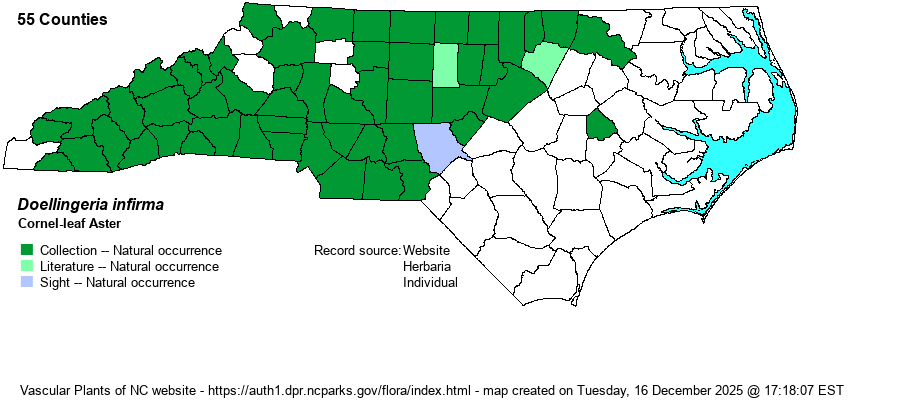| Author | (Michaux) Greene | |
| Distribution | Mountains and Piedmont; also in Greene County (roadside). Absent from the Sandhills proper. Specimens at SERNEC and elsewhere need ID annotations and updated nomenclature.
MA to KY, south to northern FL and AL. | |
| Abundance | Fairly common to common in the Mountains; and infrequent to fairly common in the Piedmont. Extremely rare in the Coastal Plain. Despite its occurrence in nearly all Piedmont counties, it is not encountered on a routine forest walk. | |
| Habitat | Mesic to dry pine-hardwood slopes and ravines, often rocky; glades; open mixed woodlands. This species does not occur along borders or large openings, but prefers shady woods. | |
| Phenology | Flowering and fruiting late June-September. | |
| Identification | Of our 3 species of Doellingeria, this is the shortest at 2 (-3) feet tall and occupies only dry to mesic soils (vs. wet). Leaves are relatively short and broad (vs. elongate). The inflorescences are much smaller than the other 2 species, but, as in both, the rays are white. Nonetheless, the 5-12 rays are rather long, and the spread flower of 1.5 inches across is easily noticed when in bloom. | |
| Taxonomic Comments | Some texts have placed Aster umbellatus var. brevisquamus here, but that is a synonym of D. sericocarpoides. Note that this is one of many composites in NC formerly included in the genus Aster, as Aster infirmus.
| |
| Other Common Name(s) | Cornel-leaf Whitetop, Cornel-leaf Whitetop Aster, Appalachian Whitetop Aster. There are several additional names with three to five words! Two words for a common name usually suffices! | |
| State Rank | S5 | |
| Global Rank | G5 | |
| State Status | | |
| US Status | | |
| USACE-agcp | | |
| USACE-emp | | |

